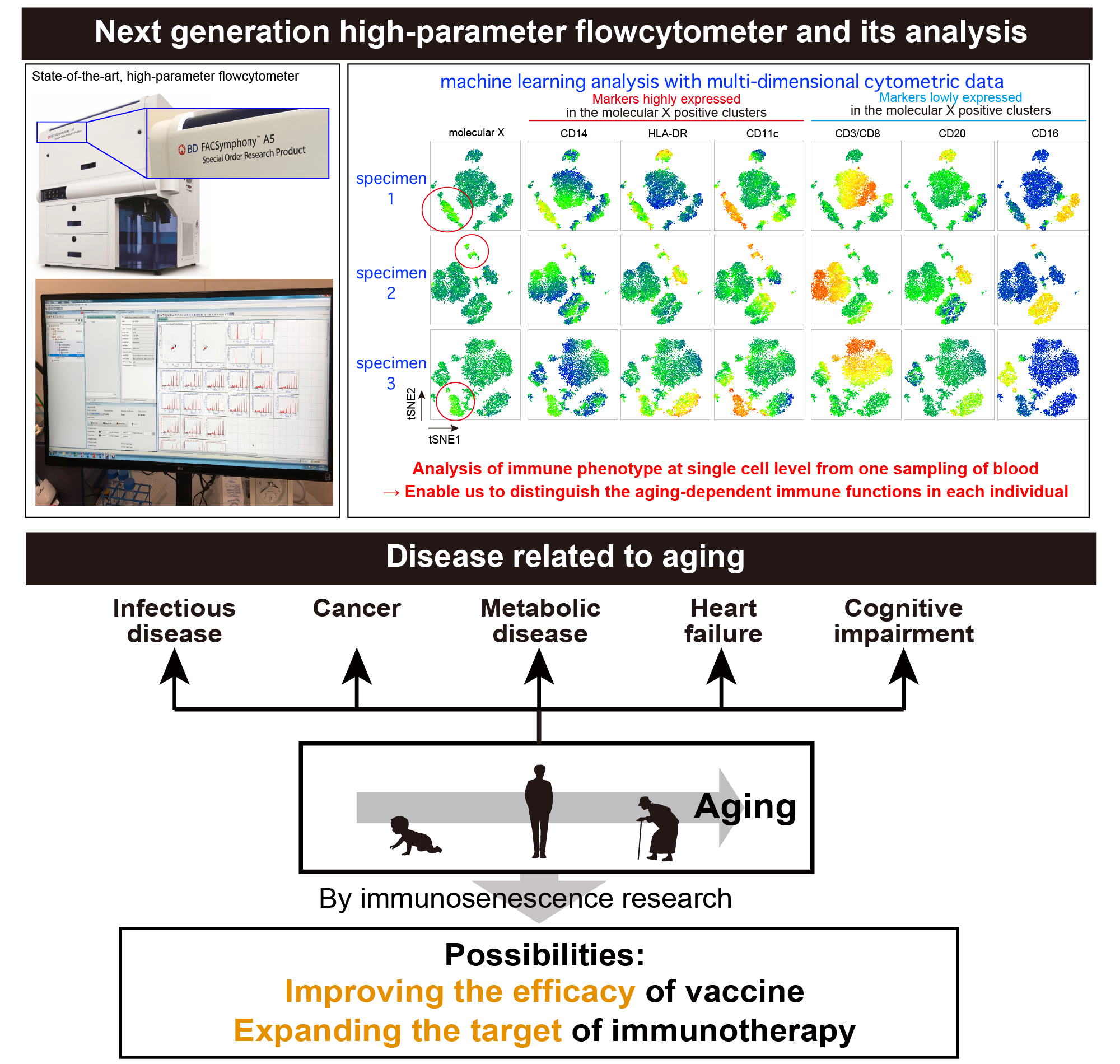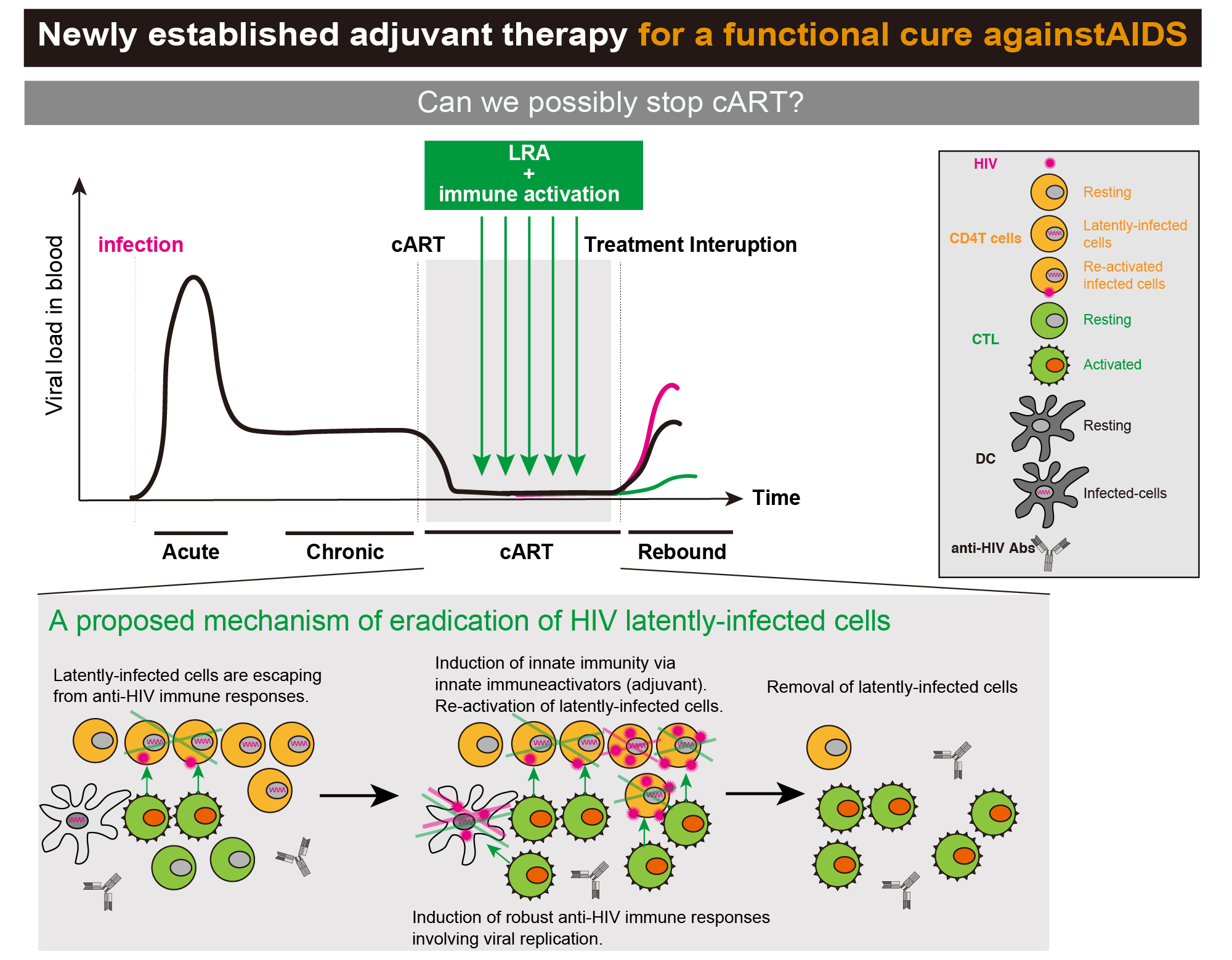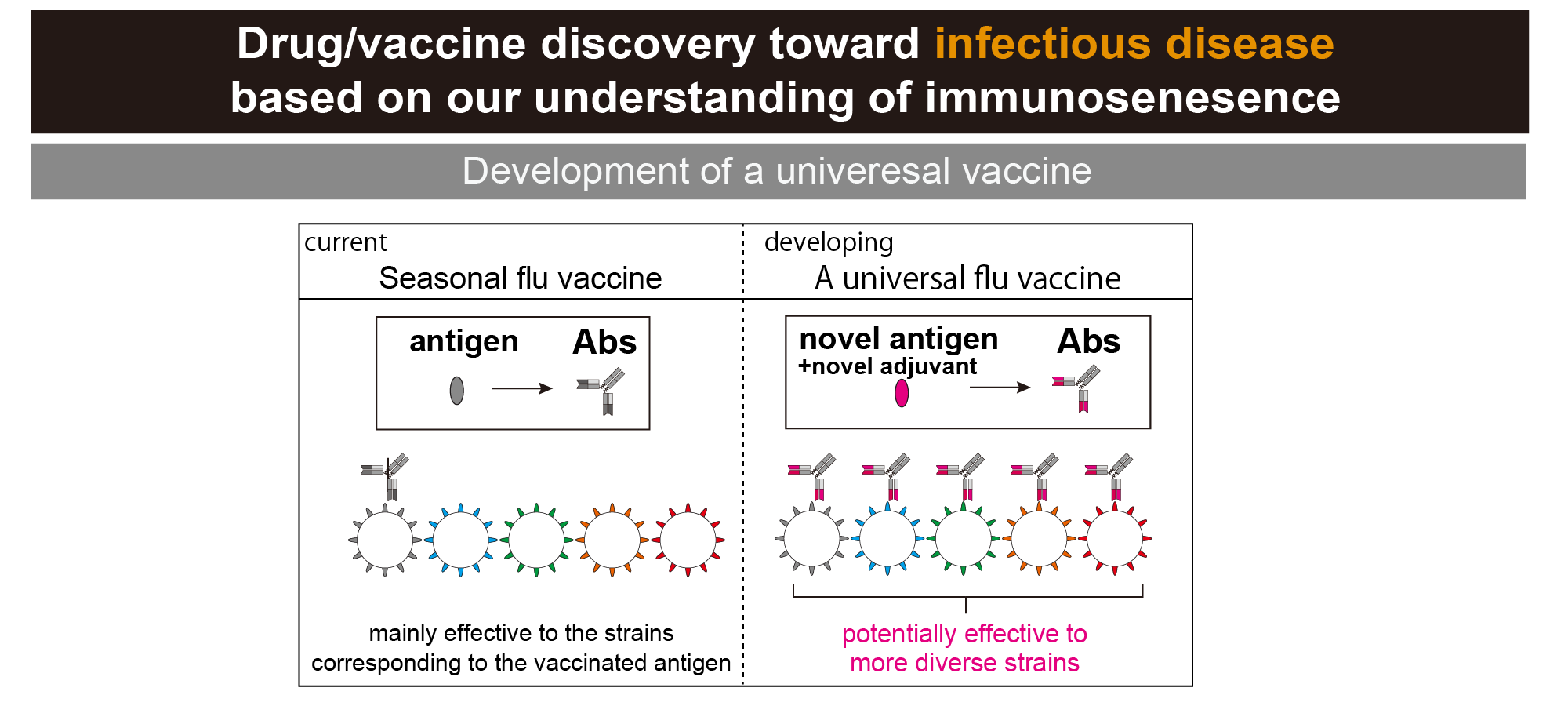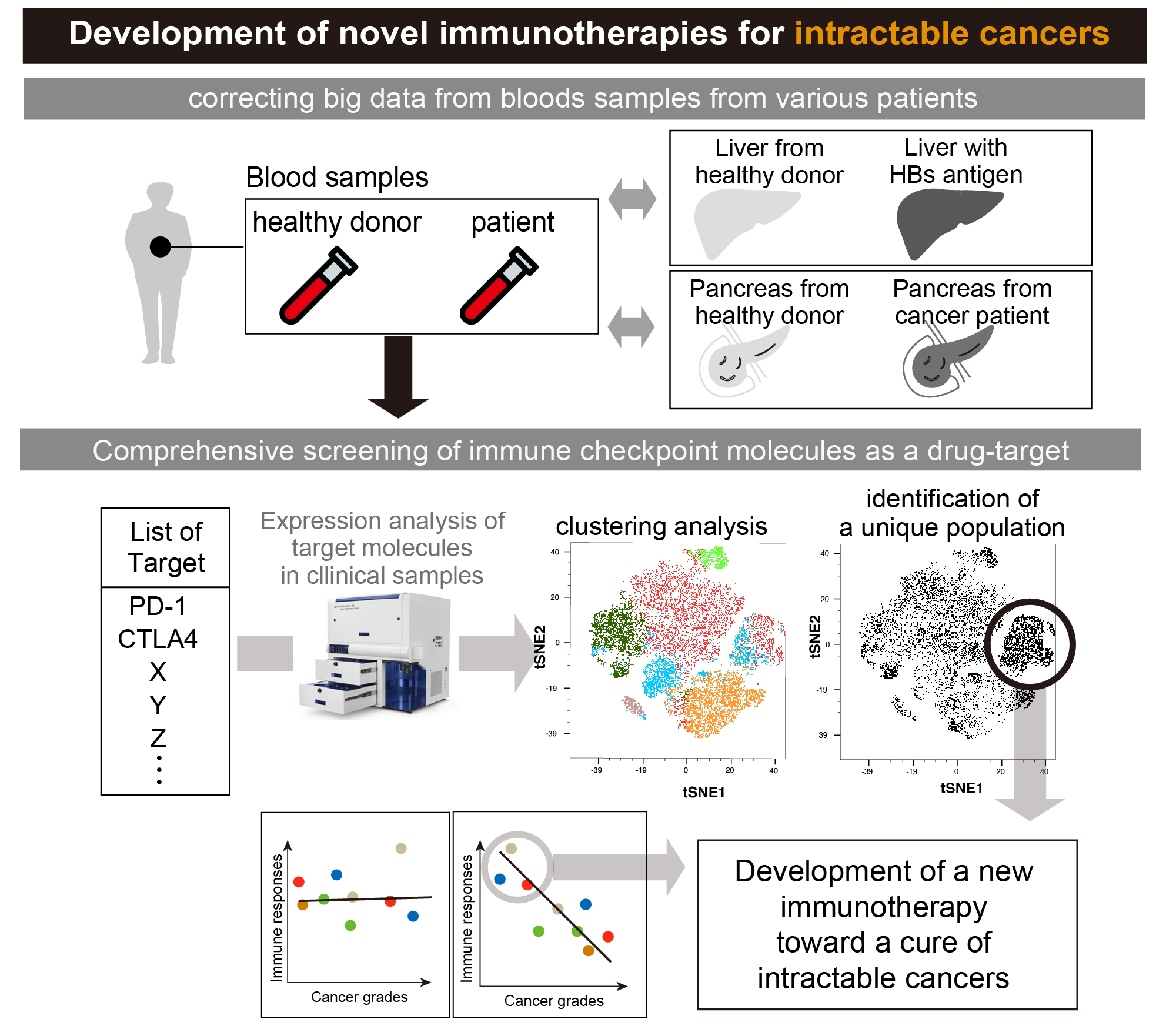 National Institutes of Biomedical Innovation, Health and Nutrition
National Institutes of Biomedical Innovation, Health and Nutrition
Laboratory of Immunosenescence
Laboratory of Immunosenescence

Living systems undergo aging at the cellular level, a process known as cellular aging. However, in recent years, the concept of immunosenescence (aging-associated changes in the immune system), at the individual level, has received a great attention. For example, we know that the death rates for cancer and infectious diseases spike dramatically in elderly patients (aged 65 or older), and this phenomenon is believed to be related to immune aging. In other words, studying the longitudinal changes in immune responses that occur as an individual ages may help to develop novel vaccines and immunotherapies based on our newfound understanding. However, we still know very little about the process of immunosenescence and how it progresses as a healthy individual ages. We have previously collaborated with Dr. Appay’s group at INSERM in France to perform an ex vivo analysis of human peripheral blood mononuclear cells (PBMCs) and discovered that as an individual ages, the naïve T cell count decreases, and that hematopoietic progenitor cells (HPCs) derived from elderly patients exhibit a decline in telomerase activity and showed abnormal phenotypes. At present, we are focused on understanding the larger picture of immunosenescence by analysis of cynomolgus monkey models, whose immune systems are reported to be very similar to those of humans. Additionally, in collaboration with Nippon Becton Dickinson Company, Ltd., we aim to make full use of next-generation high-parameter flow cytometers to carry out high-resolution analyses from individual to single cell level and develop a system to comprehensively evaluate the quantitative and qualitative changes that occur in aging-associated immunosenescence. (Click here for reference documents) Furthermore, we hope to connect these findings to the development of therapies to recuperate aging-associated decline in immune function, and vaccines of infectious disease and cancer immunotherapies for elderly people.

HIV-1 is the causative virus of acquired immunodeficiency syndrome (AIDS). Although 30 years have passed since the identification of HIV, approximately 35 million people worldwide are infected with HIV. The number of HIV-infected persons in Japan has been also rising, with recent estimates placing the figure at around 20,000. AIDS continues to be an infectious disease of critical importance to the public health of Japan. Various antiretroviral drugs have been developed to treat AIDS. While the simultaneous use of combined antiretroviral therapy (cART) has helped to reduce viral loads below the threshold of detectability in blood, the complete removal of the virus from the body in which it lies dormant has not been achieved, and once patients begin taking cART, they must continue taking it for the rest of their lives. In other words, a therapy that eliminates any remaining, latent HIV-1 infection from the cells of the body following cART can be considered as a functional cure and may lead to a radical cure for AIDS. In order to achieve such a functional cure, two things are theoretically necessary. First, the latently infected cells of the body must be reactivated and potentially died via induction of the cytopathic effect. Second, anti-HIV-1 immune responses, mediated primarily by antigen-specific CD8 T cells, must be strongly activated/expanded. Thus, we are currently involved in research aimed at establishing novel immunostimulatory therapies capable of inducing reactivation of latently infected cells and enhancing strong immune responses at the same time, which may be used alongside cART.

Influenza is an infectious disease caused by the influenza virus. It is spread all over the world and infects more than 15 million people annually. There are multiple types of the influenza virus; types A and B are especially widespread globally. The influenza virus is an incredibly diverse pathogen with various glyco-proteins embedded on the surface of the virus particle, and the specific nature of two of these surface proteins, hemagglutinin (HA) and neuraminidase (NA), is used to classify influenza virions into their subtypes such as H1N1, H3N2, and H5N1. The split vaccines currently used to combat seasonal influenza, attempt to predict which virus will become most common in a given year. Generally, surface glycoproteins from one H1N1, one H3N2, and two influenza B viruses are included as part of the quadrivalent vaccine. However, the HA protein is susceptible to mutation, and the existing vaccines do not work on virions with mutated HA proteins. Hence, the development of a vaccine capable of dealing with unforeseen viral mutations is a critical issue. Additionally, given the rapidly aging populace of Japan, an effective influenza vaccine that can be used in elderly patients is sorely needed. We are currently collaborating with the National Institute of Infectious Diseases and Sumitomo Dainippon Pharma Co. for research on a universal influenza vaccine, which will include a vaccine antigen created by methods different from those that have been used traditionally, as well as an adjuvant developed inde-pendently by Sumitomo Dainippon. Dr. Takashi’s research group at the National Institute of Infectious diseases has developed the method used to refine the viral antigen for use in this universal influenza vaccine. It is suggested that it may enable the vaccine to induce “antibodies against regions of the HA antigen where mutations cannot easily occur, and which are preserved across multiple HA subtypes.” By combining this vaccine antigen with a novel adjuvant, currently under development at Sumitomo Dainippon Pharma Co., we aim to develop a truly universal influenza vaccine with unlimited potential. Our group focuses on studying the implement ability of this vaccine. In particular, we contribute to this research effort by using next-generation high-parameter flow cytometry to find immunological correlates of protection and also evaluate the safety and efficacy of this vaccine in primate models.

Under construction.

Under construction

Pancreatic cancer has one of the worst prognoses of all the gastrointestinal cancers, and the five-year survival rate is said to be less than 10%. The biggest reason for this is that early detection of pancreatic cancer is extremely difficult. A great deal of research into early diagnostic markers for pancreatic cancer has been conducted, but tumor markers more efficient or more easily detected than those already known, are yet to be found. Furthermore, only 30-40% of cases are eligible for surgery, which is the only radical therapy available for treatment. Anticancer drugs are largely ineffective on pancreatic cancer, only a few selected drugs are known to work properly, and many newly discovered molecular-target drugs and immunotherapies have been ineffective. This makes the prognosis quite poor. Why exactly is pancreatic cancer so intractable? We believe that understanding the types of immune responses occurring after the onset of pancreatic cancer and elu-cidating its pathology are critical to the development and establishment of an effective therapy for the disease. In collaboration with the Osaka University Department of Gastroenterological Surgery, we have used next-generation high-parameter flow cytometry to analyze the profiles of hemocytes (primarily T lym-phocytes) in pancreatic cancer patients at different stages of the disease, enabling us to elucidate the mechanisms of immune response to pancreatic cancer. Furthermore, we aim to identify markers for early diagnosis, identification of treatment effects, and prediction of disease prognosis based on these results.
HBV is the causative virus of hepatitis B. Approximately 90% of patients with chronic hepatitis B caused by HBV infection experience no progression of the disease; only in 10% of cases does infection lead to cirrhosis or liver cancer. Immune responses are believed to be involved in the processes that determine the direction of a patient’s pathological progress. Additionally, HBV is seen to be eliminated from the system in 95% of cases in which patients were infected for the first time in adulthood, as long as patients’ immune systems were normal. Therefore, it is almost certain that anti-HBV immune responses are critical to the management of HBV. The nucleoside analogues (NA) are the primary therapies currently used to treat hepatitis B and HBV-induced cirrhosis. The use of these drugs to reduce HBV-DNA appears to halt the progression of the disease into cirrhosis or liver cancer. However, only 3-4% decrease in HBs antigen is seen, even after long-term use of nucleic acid analogues. In other words, even when long-term use of NA has lowered HBV DNA below the detectable threshold, in many cases, covalently closed circular DNA (cccDNA) or the HBV genome is still present in liver cells, and it is believed that these viral elements cause liver cancer. Hence, the currently adopted target for clinical evaluation of the therapeutic effect is the HBs antigen level, which is believed to correlate with the risk of cancer onset. In order to achieve a functional cure, we aim to first use NA therapy to reduce HBV DNA below the threshold of detectability in blood and then stimulate the patient’s immune system to eliminate any re-maining HBV-infected cells. This research is being conducted in close cooperation with many domestic collaborators, such as the Research Center for Hepatitis and Immunology at the National Center for Global Health and Medicine.
